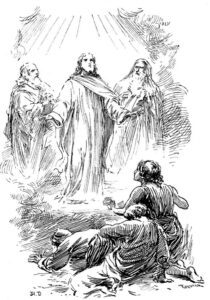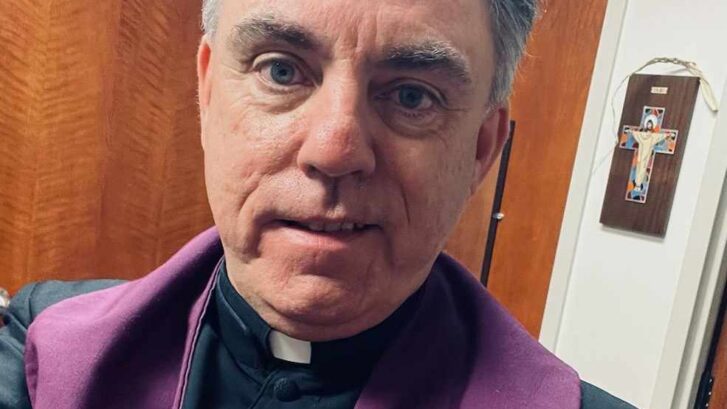HERE ARE SNIPPETS OF THE LITURGY OF THE WORD FOR TODAY
God put Abraham to the test. He called to him, “Abraham!” “Here I am!” he replied. Then God said: “Take your son Isaac, your only one, whom you love, and go to the land of Moriah. There you shall offer him up as a holocaust on a height that I will point out to you.” –from Genesis 22.
My vows to the LORD I will pay in the presence of all his people, In the courts of the house of the LORD, in your midst, O Jerusalem.—from Ps. 116 “
If God is for us, who can be against us? He who did not spare his own Son (ref. on The Cross) but handed him over for us all, how will he not also give us everything else along with him? –from Rom. 8
Jesus took Peter, James, and John and led them up a high mountain apart by themselves. And he was transfigured before them… As they were coming down from the mountain, he charged them not to relate what they had seen to anyone, except when the Son of Man had risen from the dead. So they kept the matter to themselves,.Mt.9
“MOUNTAIN CLIMBER”
The readings today take us up three mountains, FIRST with Abraham and Isaac on Mt Moriah; and THEN In the Gospel, up on Mount Tabor with Jesus in His Transfiguration event, and ALSO in the in-between Scriptures to show how the Psalms point up to Jerusalem, and the epistle text recalls the sacrifice of the Son of God on Mt Calvary in that very city of David.
Scripture-wise, we go mountain climbing.
Whenever one climbs a mountain, or goes up a height on high ground via a vehicle drive or gondola transport, lucky you, you see things differently, and from a high vantage. I recall going up the Killington Vermont Ski Resort Gondola one time—what a sight to see things anew when you’re up 3000 feet! The view to down below gives a new perspective, but also the openness to the sky above changes one’s sight and feeling, too—with the eyes but also for the eyes of the soul.
There is much drama on these Bible mounts in today’s Scriptures. Abraham and Isaac are atop Moriah, with God testing them. David’s telling of Jerusalem as God’s pole of the earth matches up with what happens at Mount Calvary to Jesus, in His dying and rising. Its act becomes center and core of Christian faith now—even now it is our center of history. Then, up in Matthew’s gospel we go to Mount Tabor, as the Lord Jesus lifts up the gaze of three main disciples to note His divinity and power, in an unveiling epiphany to them. In His Transfiguration, He shows them a mountain-top elation that will strengthen them later and help them lead other disciples and apostles to note how Jesus is God then and after the Resurrection and always—and God is in control. The Old Testament Jewish feast of Booths gives way now to Christ’ fulfillment and new life of faith.
We’ll get back to hill hiking and mountain climbing… but first. Let’s go a level deeper with the readings!
The first reading takes place on a mount Moriah, and it seems very strange to our ears. But Abraham belonged to the Chaldean people, and in those times they thought it was perfectly acceptable to offer their children to their gods in the way that Abraham was going to do. But God called Abraham to leave the Chaldean people and to go to a place that He would show him. So, on Mt Moriah, God showed Abraham to leave the ways of the Chaldeans behind, and to offer sacrifice to the true God in a new way. God would introduce what to do, in a covenant pact, which would involve God’s Sacrifice to come, and the Jews animal sacrifice “tithe” provision.
Let’s put it in a 2024 view at that mount. We can be as immersed in the culture of our day as Abraham was in his. And we need to be shown a new way from it: God’s way. There are many false gods in our culture, come in forms of electronic entertainment, appearances, lusting for money and pleasure, power and control, and following the idea that we can do whatever we like so long as we think we’re not hurting anyone. Like Abraham, God calls us to discover again our fidelity to the one true God and to serve and please Him first.
In the second reading, on Mount Calvary, where Our Lord died on the Cross for us, we are invited to see that it is a Person who saves us, redeems us, forgives us and leads us home to God. God is a personal God, made flesh in the person of Jesus Christ. The invitation to ‘climb’ Mount Calvary is an invitation to embrace the life, death and resurrection of Our Lord through which we are saved and made free. Not by efforts of our own, but by his free gift which he offers to us. Yet we need to hike the Way of the Cross in response to God.
And then, in the Gospel, the invitation to climb Mount Tabor is an invitation to look into heaven, and to realize that what we see around us here on earth is not the end of the story. We’re not made just for this–we are made to share the life of the Blessed Trinity, a life that is total love, joy, and freedom to be what we were created to be. This glimpse of heaven would help the disciples to keep their eyes on their destination, even when days would be dark and confusing. Pray for that glimpse or taste to keep you going along. Know that a taste of heaven is in the Eucharist coming to you—that’s the Eucharistic Amazement in the Church theme of this year. I heard of some Catholic people saying that their not following that theme for themselves—uh, big mistake. We need our signs in the Sacraments.
And so, at the beginning of Lent, let’s heed the call to look at our lives in a new way. Maybe in believing John 6:33 of Jesus being “The Bread which comes down from Heaven” can be a Lenten vision. May this Lent purify us, and help us become more totally into the Lord and His gift of unity.
Now back to the hiking illustration and using the mountains and hills in the Scriptures today.
I don’t know when last, or ever if, you took a hike up a tall ascent. I won’t put it past you, as I hear of amazing stories of you and of senior accomplishments. (*I am preaching both Masses at Riderwood on Sunday.) Last Spring, an 80-year-old Japanese mountaineer became the oldest person ever to reach the summit of Mount Everest. Despite a history of heart problems, Yuichiro Miura, who climbed Everest when he was 70 and then again at 75, reached the peak again, in a great feat with his feet. ☺
That one will beat all other hill or mount-climb stories, but you might have your own hill climb or mountain climb story. For myself, I recall many years ago going up Bear Butte in South Dakota, a mount peaking high over the prairie land around it. The trail was steep and lined with mandalas on the trees, showing it was used not just as a physical climb but a spiritual one, first by Native Americans of the Plains. It was a most satisfying moment to get to Bear Butte top, hiking it with a friend Bryan, reaching its 4246 feet above sea level height, and having only eagles flying up there at that space, in soaring winds that pushed nearby clouds quickly by. Unforgettable. It was taken as a spiritual action, and in all respect to the Native American sacred mound which we trod, we hiked it while using our soul prayers to Christ Jesus. I was spiritually affected by that climb for the rest of my life.
In some ways, taking a hike in life is a metaphor for our lives, as like a journey taken day-by-day. Where are we headed for?
As Catholics it is for the mountaintop experience of God at His Home of Heaven. St. Paul strangely said once: “to live is Christ, and to die is gain.” As we trod in our lives, with all our experiences going on, and try to make them as spiritual steps to get closer to God, the joy we hope for is life with God for eternity. This was Paul’s hope; it is our own. We fear not death, then, or even the dying process, for that part of the journey to its finish is all part of the climb. Someday we’ll reach the peak where we’ll see God as He is. This thought ties to the Transfiguration Event. Peter, James and John got a glimpse of the glory, in seeing the Lord Jesus suddenly pull a veil to reveal the holy wonder, light and brilliance of Himself, The Eternal Son, on mission on earth. Jesus was strengthening these key three disciples for the last difficulties of the road ahead.
Some of you have had glimpses or ‘knowings’ or hints or maybe even clear signs that the life-hike you take is all greatly worth it and real. “Straight is the path and narrow is the way,” and you are basically on that trail. It’s good to know it and believe it. Jesus is real and He’s your Shepherd for home. Mt. Calvary and the Sacrifice of Jesus is ours, as the epistle says today, and Him we hold as Savior and Atonement and Reconciliation for our sins. Rather than live in drudgery, like a weary hiker ready to fail and give up, we walk this climb in the company of Christ Alive and with some of His friends that He’s put on the trail around you.

Life can be like a whole lot of steps made, some with trying difficulty, but one fine day, we’ll get gloriously what we already possess in our soul in this blessed but earthly manner. There is a New Jerusalem atop this climb of faith. If today’s Psalm 116 got us thinking of being in the courts of The Lord in Jerusalem, then add on the start of Psalm 121 for your hike. “I lift up my eyes to the mountains—where does my help come from? My help comes from the Lord, the Maker of heaven and earth. He will not let your foot slip—The Lord watches over you.”
You might have had some retreats in life, or some good guides, or model teaching in the Faith, or love to bring you inspiration for the pilgrimage upward. Thanks be to God and His Grace for that. A song goes “we’ve come this far by faith, leaning on The Lord, trusting in His Holy Word, He’s never failed us yet.”
There may be a break in the trees on the mountain trail of life, and one that gives a vista of to where you are. It may be a great view. Take it in. God is glad for the progress you have made. There is some more to go. But say today with Peter on Mount Tabor: “Lord, it is good to be here up with you!”
Fr. John Barry

